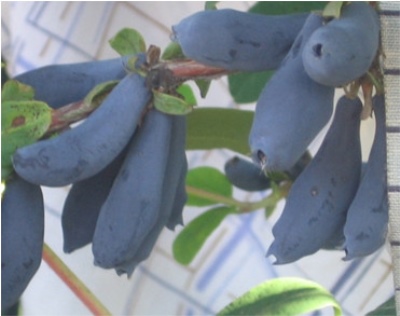
- Authors: Savinkova N. V., Gagarkin A. V. (FSUE "Bakcharskoe", village Bakchar, Tomsk region)
- Name synonyms: 4-4-80
- Growth type: undersized
- Description of the bush: medium density, oval
- Bush height, m: up to 1.3
- Leaves: elongated oval
- Transportability: high
- Fruit size: large
- Fruit weight, g: 1,8-2,4
- Fruit shape: elongated teardrop
Honeysuckle is a cultivated plant that is unpretentious and perfectly adapted to harsh weather conditions. It is widespread among breeders due to its sweet fruit and easy maintenance.
Description of the variety
Blue Cliff is perhaps the most popular variety of honeysuckle, widely used in the vastness of Siberia, the Urals and the Far East, due to its resistance to cold and constantly changing weather. In appearance, these are low-growing bushes of medium density, the height of which does not exceed 1.3 meters. Differs in oval leaves and blue oblong fruits.
Fruit characteristics
The fruits of the Blue Cliff look as follows: blue or dark purple of small size - 1.8-2.4 g, with a strong waxy bloom. There are few "seeds" inside the fruit, they contain a large amount of vitamin C - 42.3 milligrams per berry, as a comparison, there is only about 40 milligrams in lemon.
Taste qualities
Most people and the tasting panel find Blue Cliff fruit very tasty. The berries are slightly spicy, sweet and sour, and the aroma is moderately pronounced.
Honeysuckle of this variety is universal in its application. The fruits can be eaten fresh, but can also be safely used in preparations for the winter. The berries make a very tasty compote and no less tasty jam, with a delicate aftertaste and rich color. The Blue Cliff also lends itself well to freezing, it is well stored both with sugar and in "pure" form.
Ripening and fruiting
The fruits of the Blue Cliff begin to ripen by the beginning of June, finally becoming ripe by the middle of the month. Some natural timing shifts are possible due to cold rainy weather. Ripe berries hang in clusters on the branches, and honeysuckle is capable of bearing fruit for about 15 consecutive years.
Yield
With proper care, watering and timely fertilization from only one bush of the Blue Cliff, it is possible to collect about 2.9-4.5 kilograms of ripe berries. Ripe fruits are approximately the same in weight and size. The crop is harvested throughout June and until the end of July. When picking, the berries are easily and dryly separated from the cutting, without emitting juice and without getting your hands dirty.

Growing and care
By their structure, the roots of honeysuckle are close to the surface of the earth, so you need to dig up very carefully so as not to damage the root system of the plant in any way. With the same care and scrupulousness, it is necessary to remove the weeds that have grown around.
A variety such as Blue Cliff can be planted next to barberry or black currant bushes. If apple, cherry or plum trees grow nearby, this will also have a beneficial effect on honeysuckle.
You can feed with nitrogenous fertilizers in the spring, and in the fall - with phosphorus or potassium.Pruning is recommended as follows:
- in the first year of planting, cut off the seedling, leaving several especially strong shoots;
- regularly remove dry or diseased branches, making room for the young and healthy;
- once every 7 years, you can carry out extensive cleansing rejuvenating pruning, leaving only young shoots.
It is better to treat the plant with chemicals in the fall so that toxic substances do not accumulate in the soil and then do not get into the plant. Insecticides are used to control pests, and fungicides are used to treat diseases.


Disease and pest resistance
For a long time it was believed that parasites do not live on honeysuckle of any variety, however, in practice, the owners unexpectedly found out for themselves that it is necessary to constantly protect the plant from pests and diseases.
If not properly maintained, Blue Cliff is most often exposed to diseases such as:
- ramulariasis - whitish spots with a brown border of fungal nature;
- cercosporosis - burgundy-brown ulcers on the leaves, the activity of fungi;
- tuberculariosis - bright orange, yellowish or white-milky ulcers on the bark of a bush;
- powdery mildew - a whitish coating on the leaves;
- the mosaic virus of the rash - the formation of a contrasting pale plaque on the leaves.
Frequent insect pests on the plant:
- aphids - small green bugs;
- gooseberry moth - white motley caterpillar with yellow-black specks;
- various scale insects - round-shaped bugs of brownish color;
- fingerwing honeysuckle - whitish, gray or pinkish butterfly with fluffy wings;
- rose leafworm - green, velvet to the touch, caterpillar.

Location and soil requirements
The Blue Cliff variety is absolutely not picky about the soil on which it is grown, nevertheless, the shrub will take root best of all and will give a bountiful harvest if planted in loose, crumbly, slightly acidic soil. It is better to plant in slightly shaded areas, since it will not be good for honeysuckle to get an excessive amount of direct sunlight. Also, when planting, you should in every possible way avoid swampy and overly humid areas, as well as arid hills.
































































